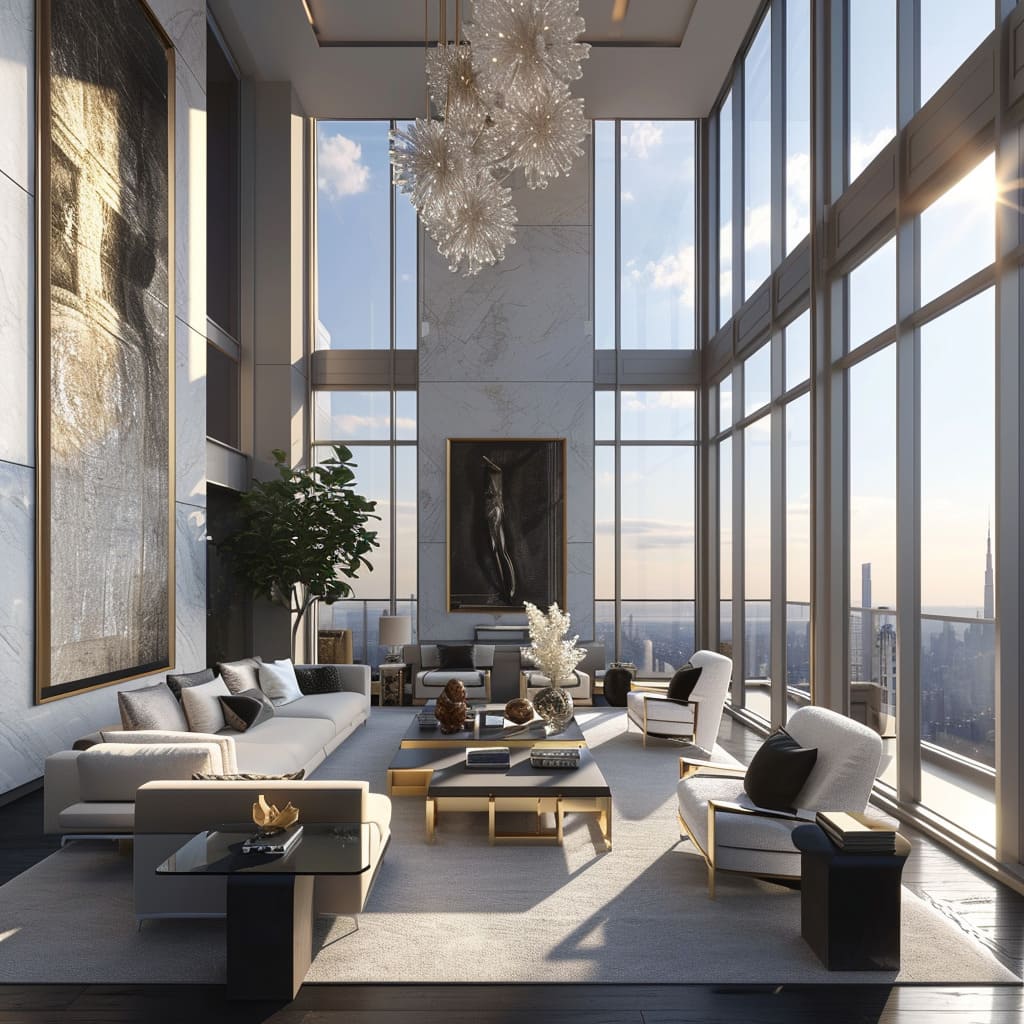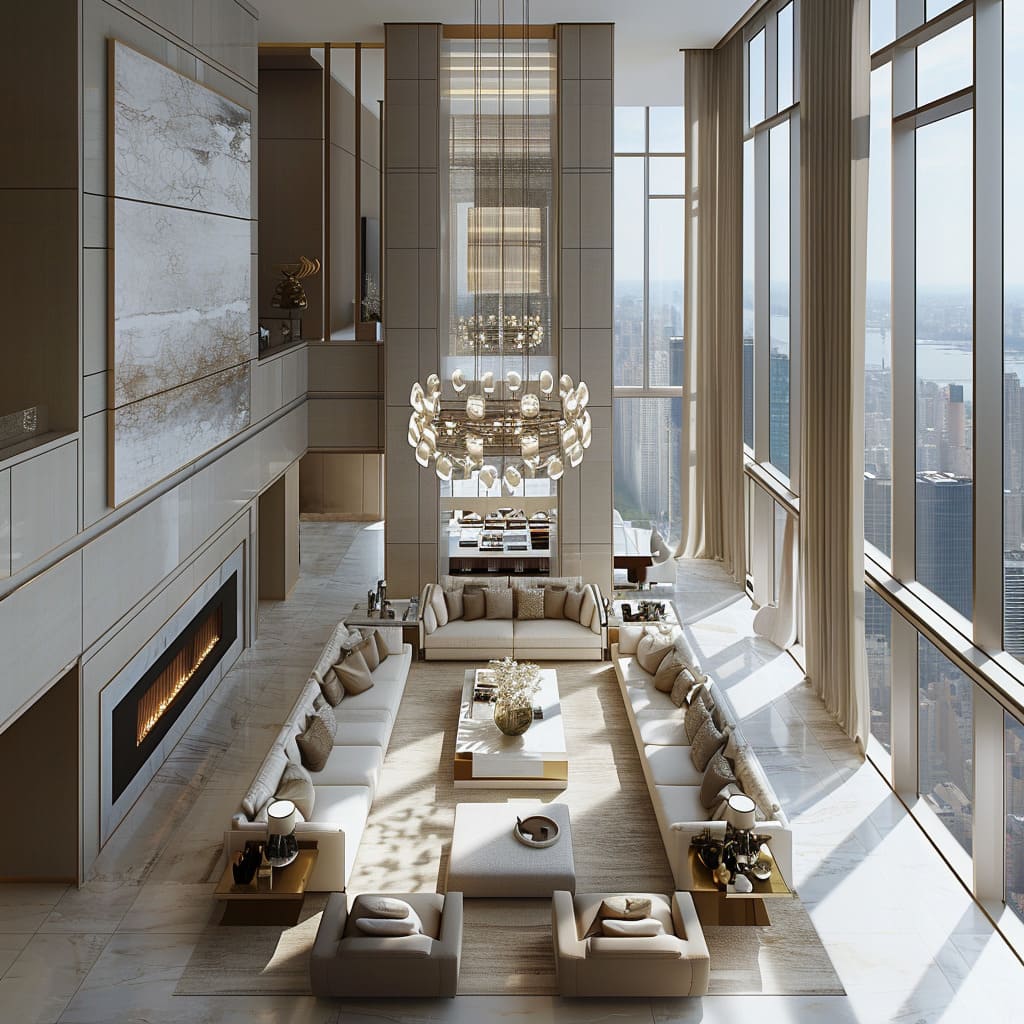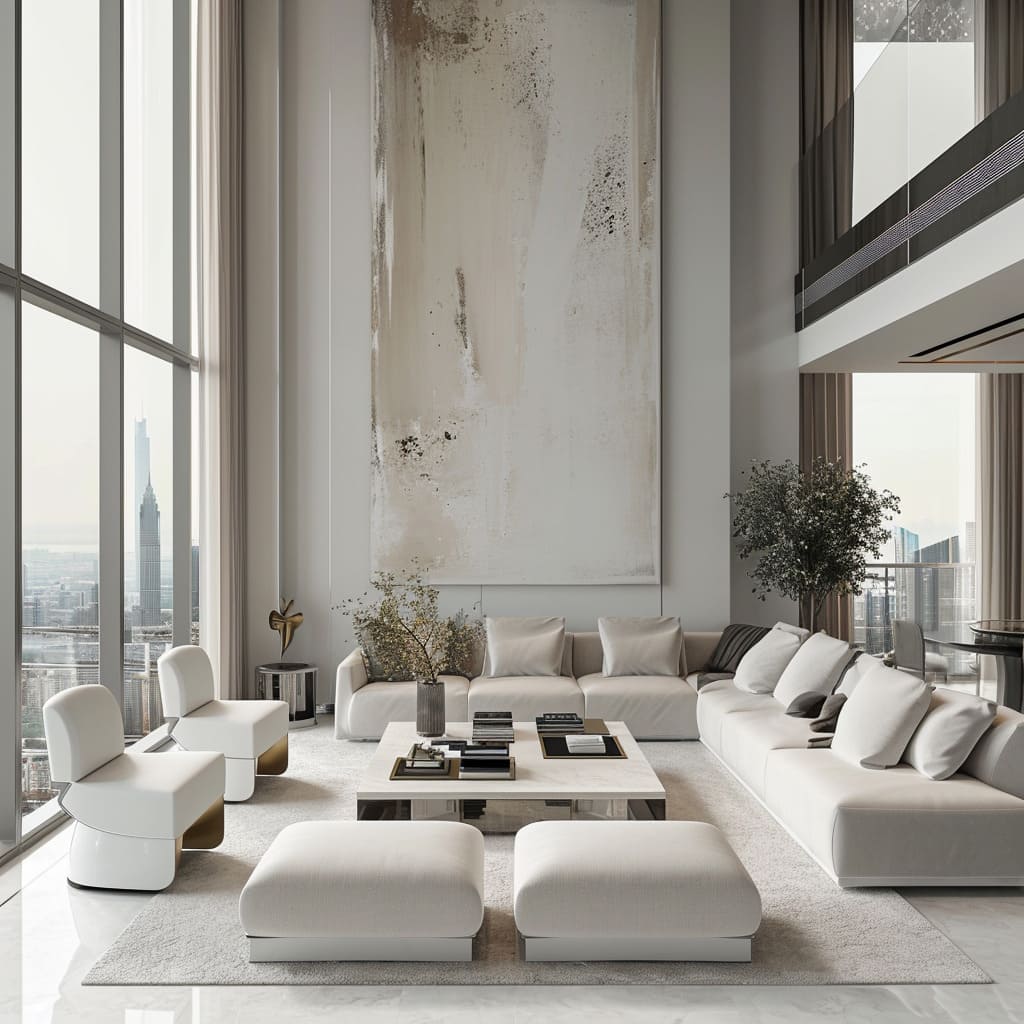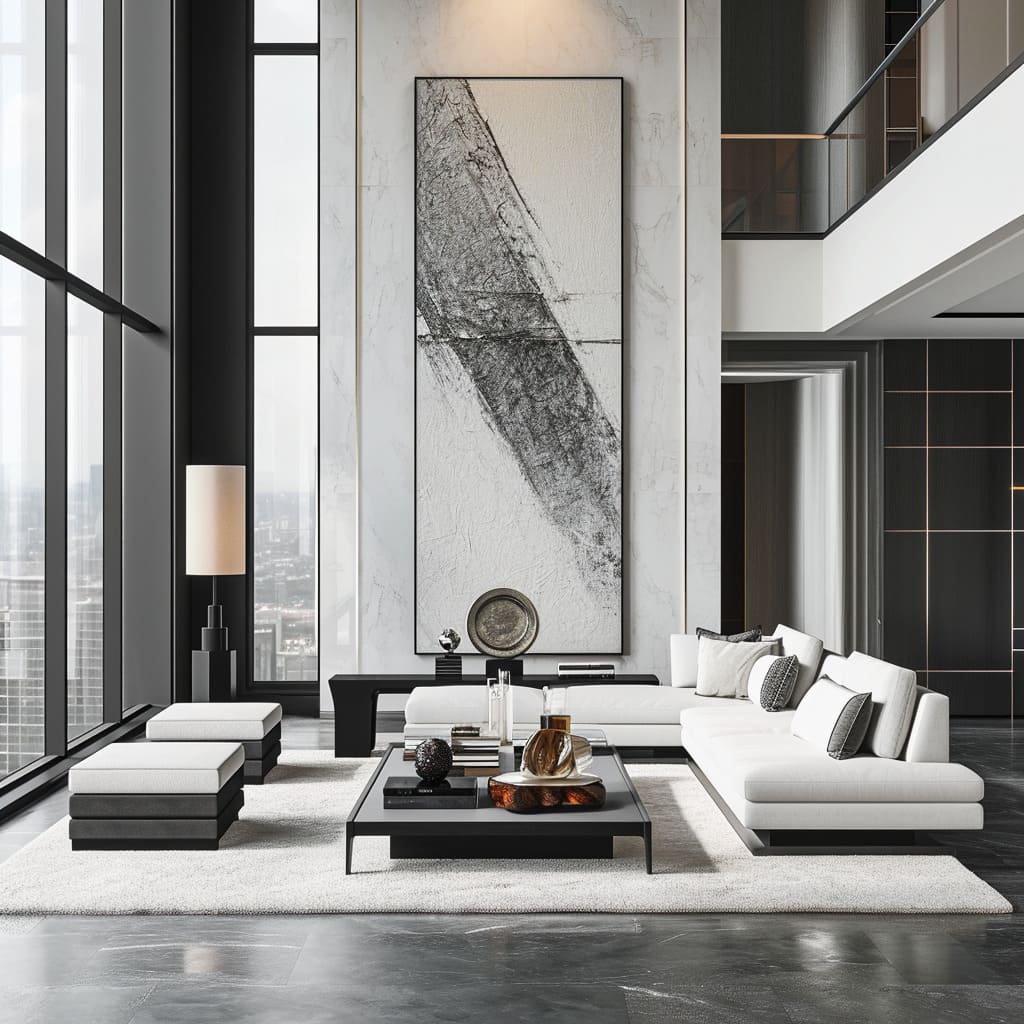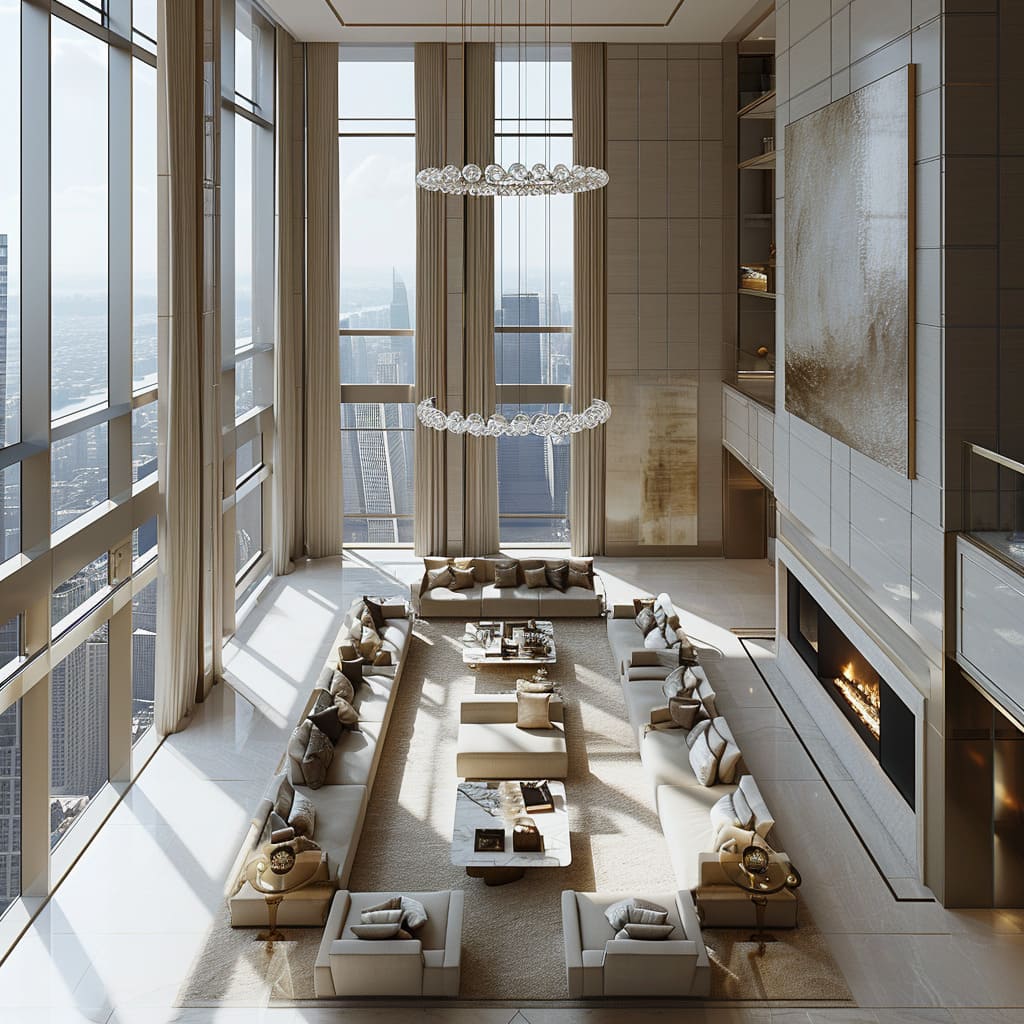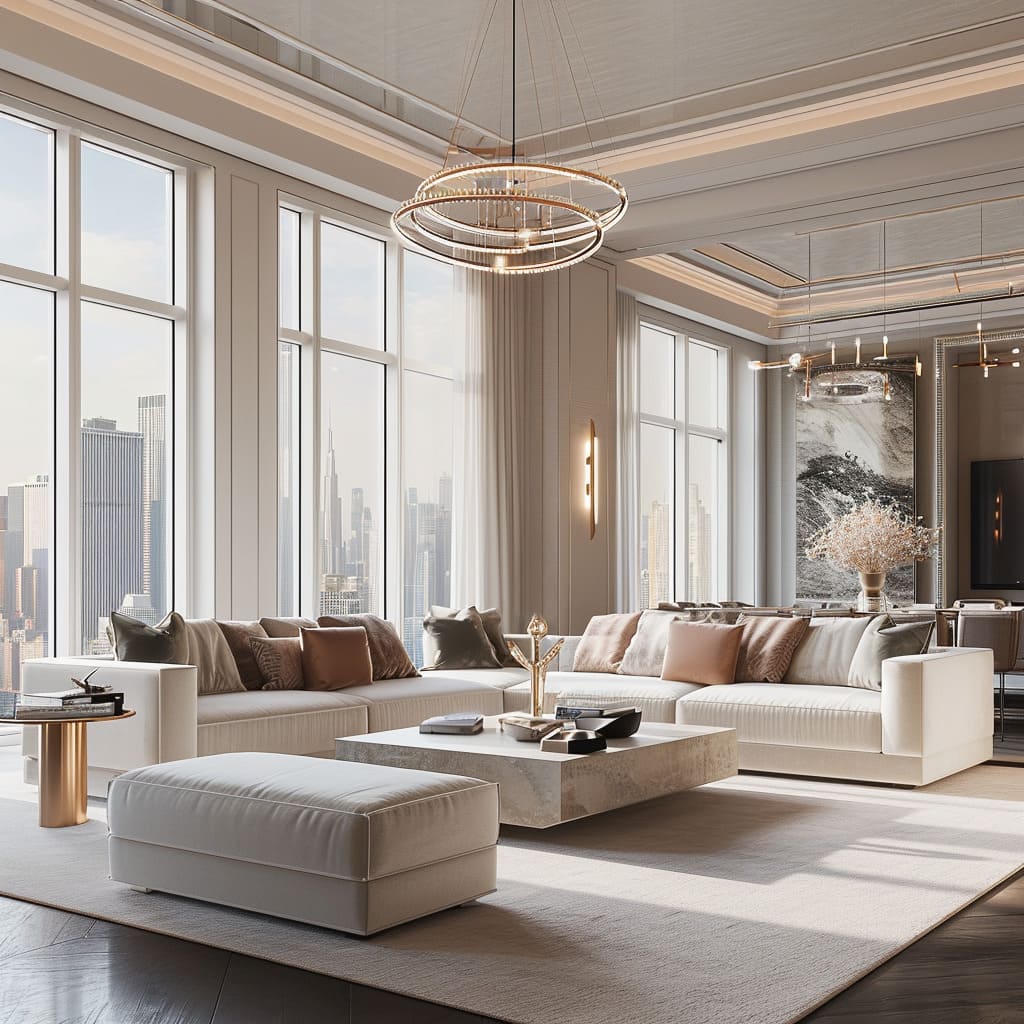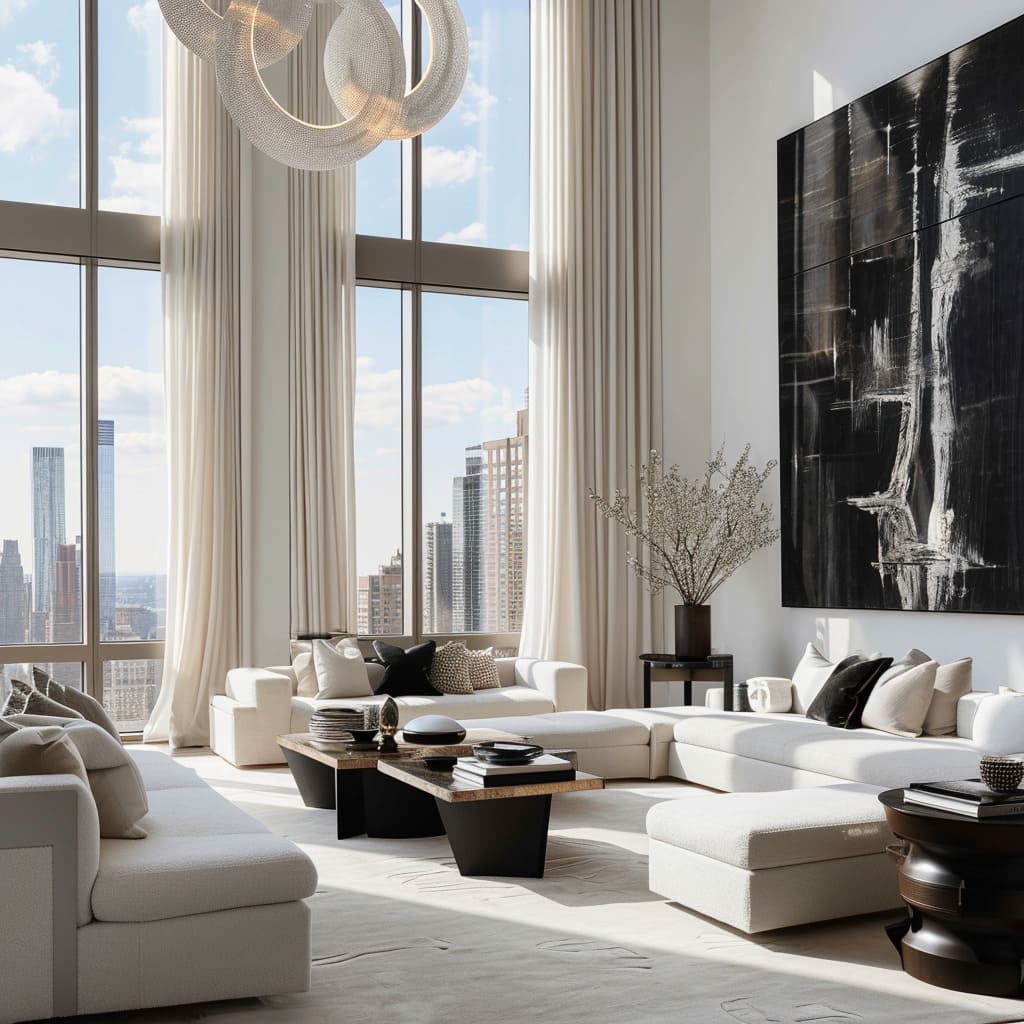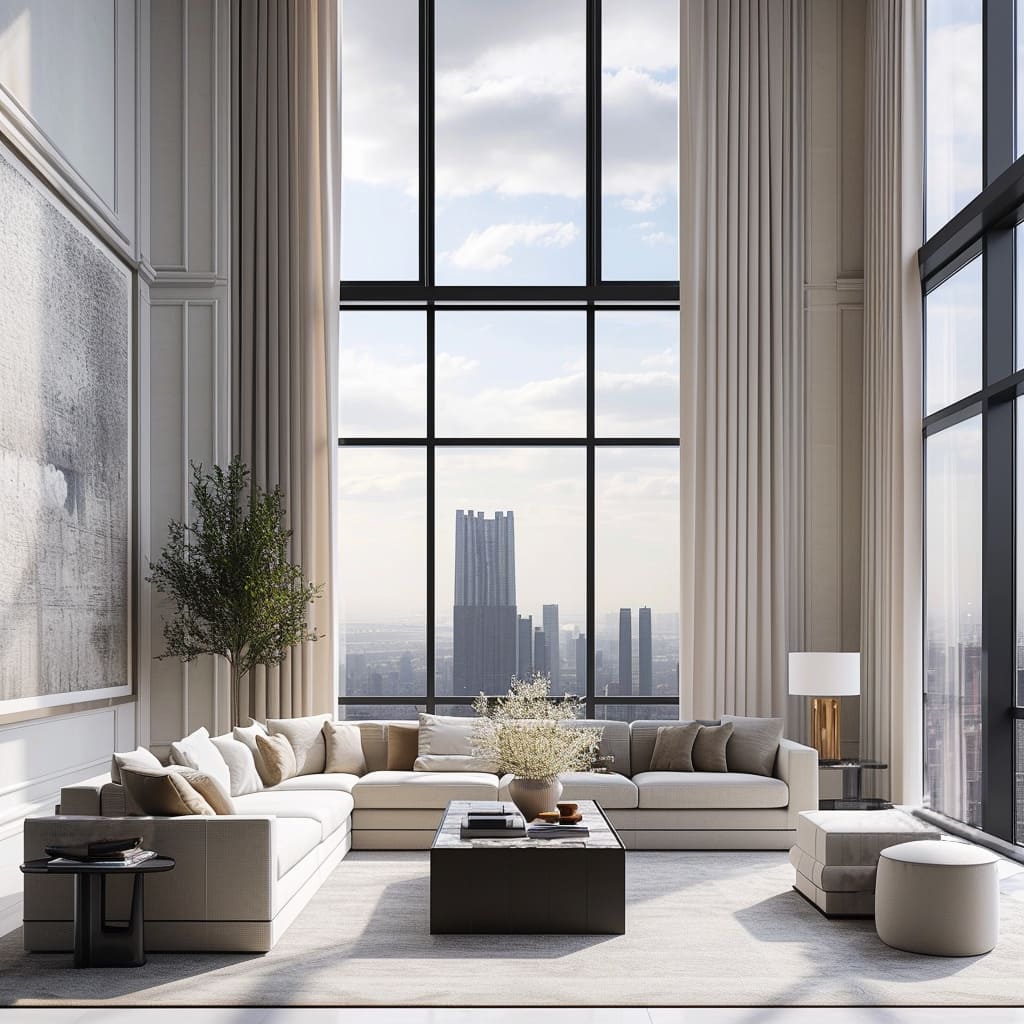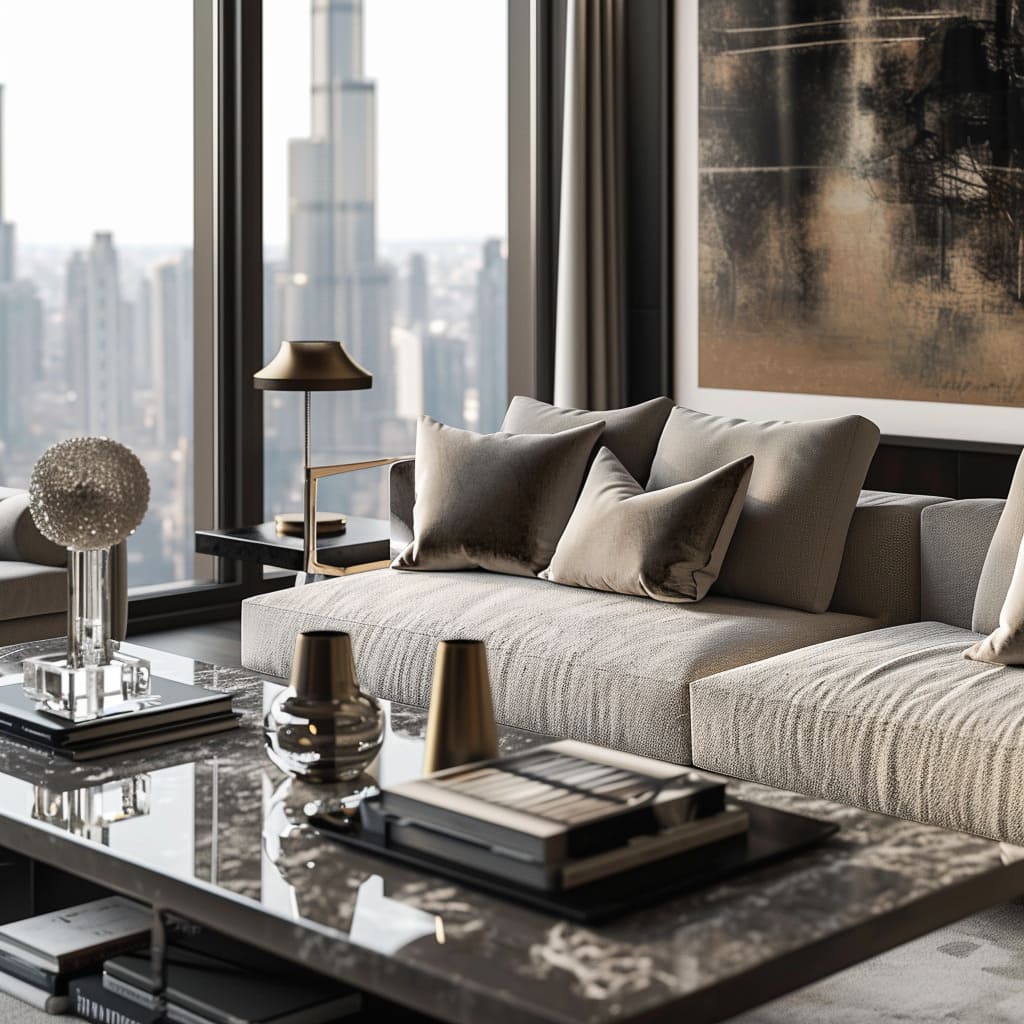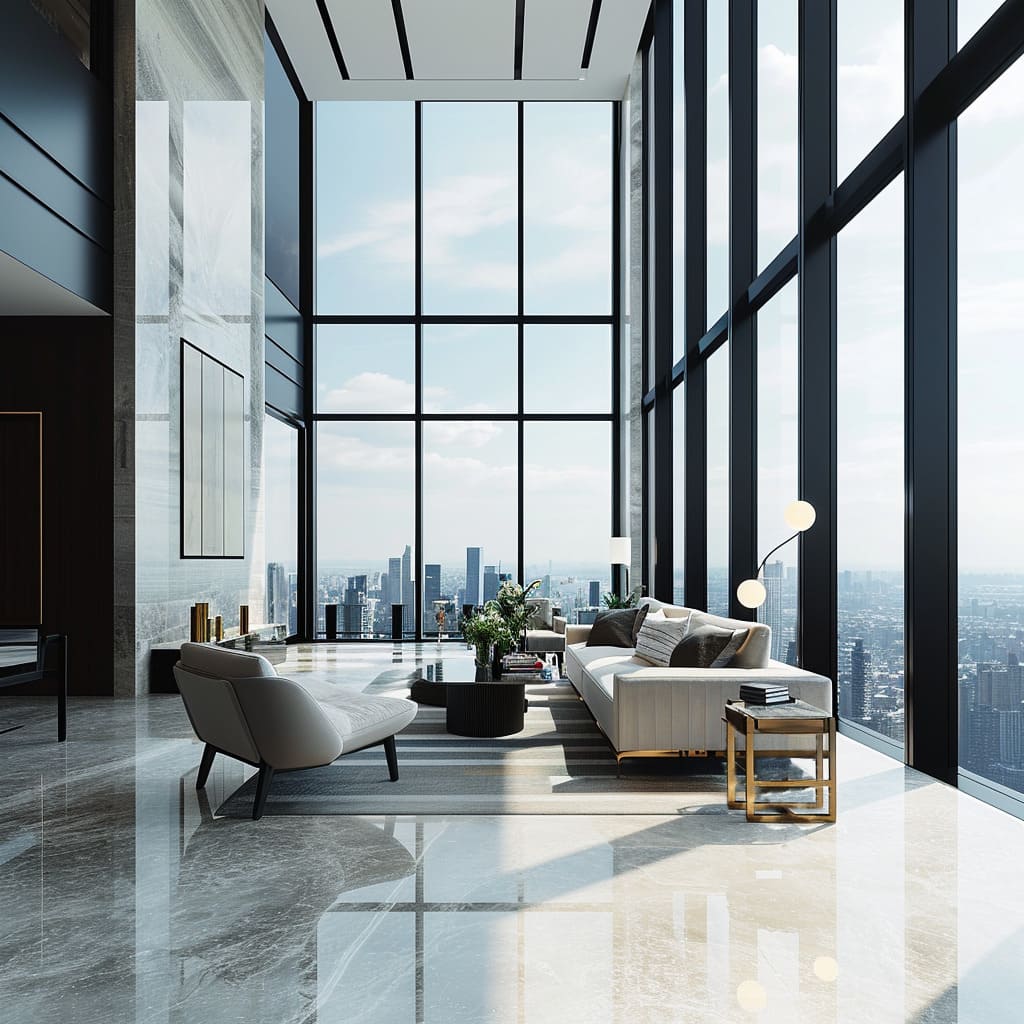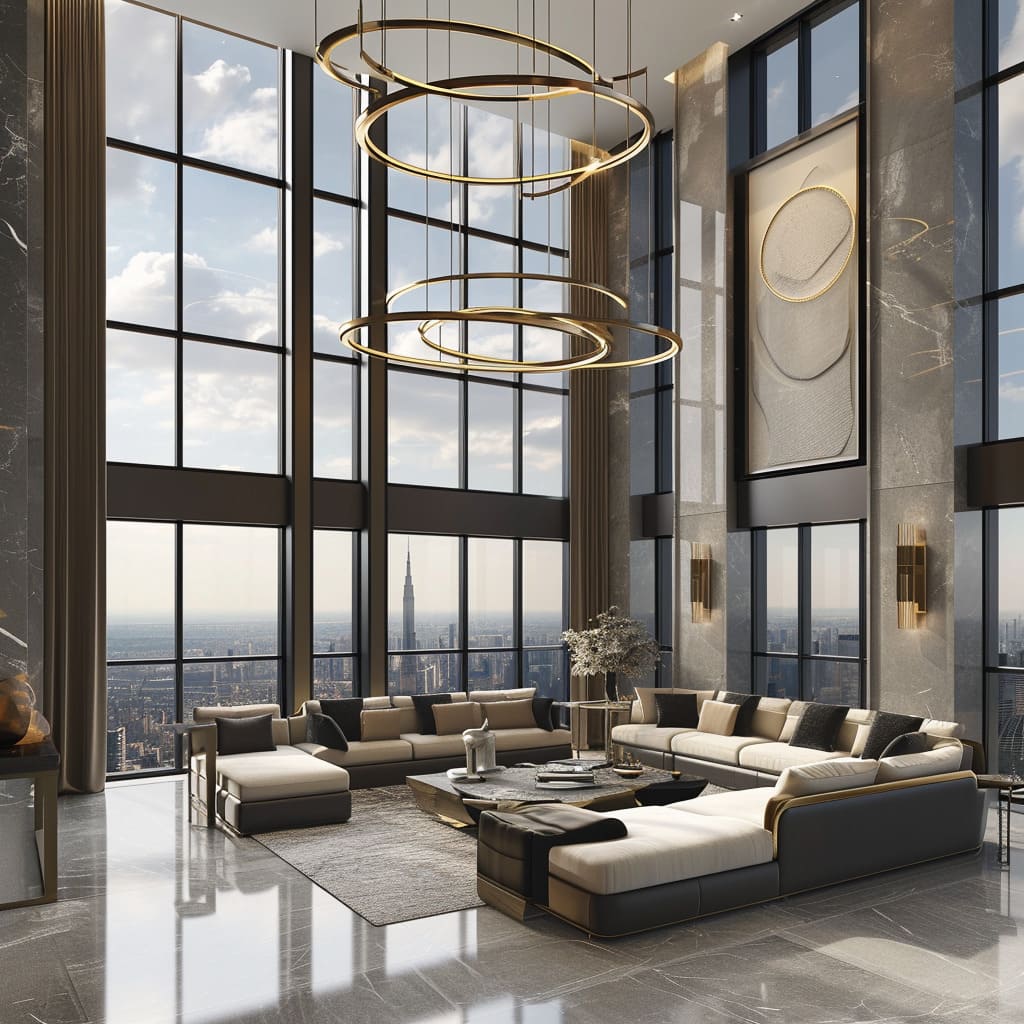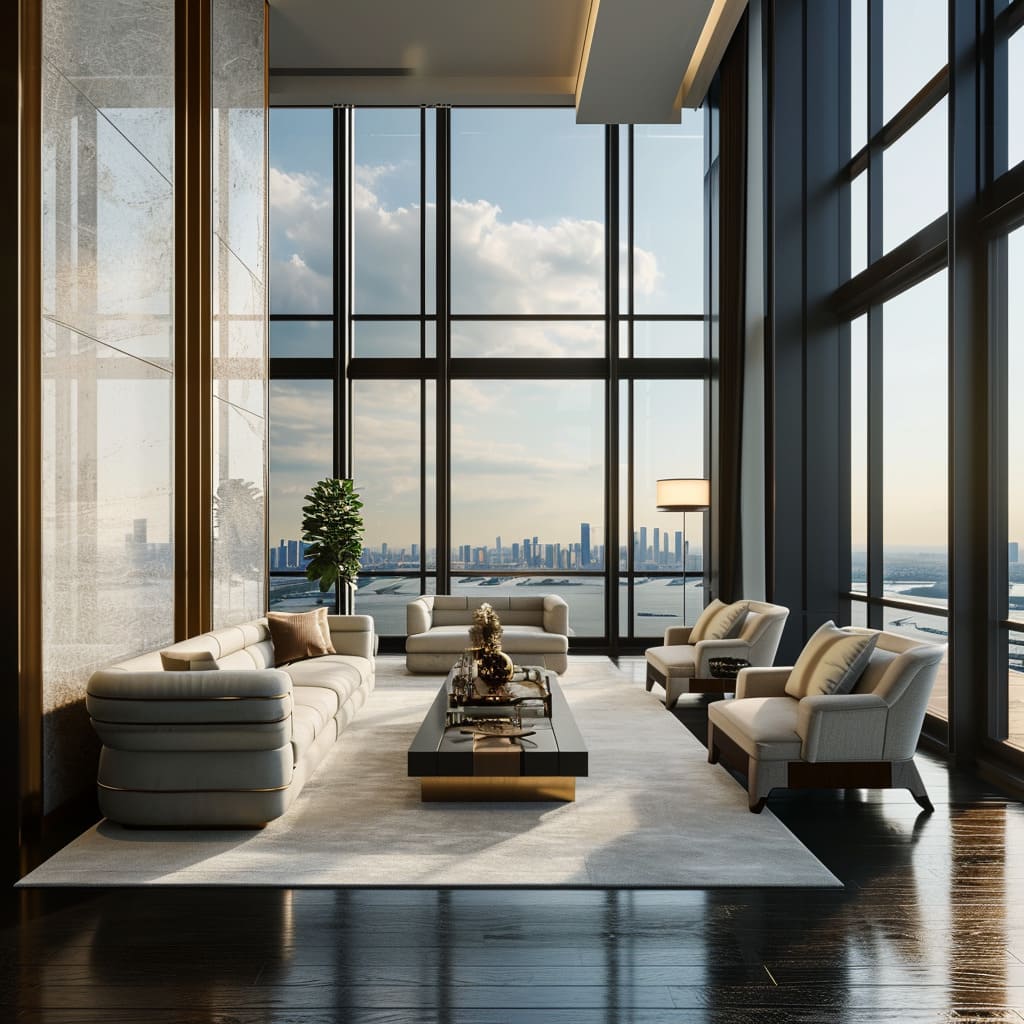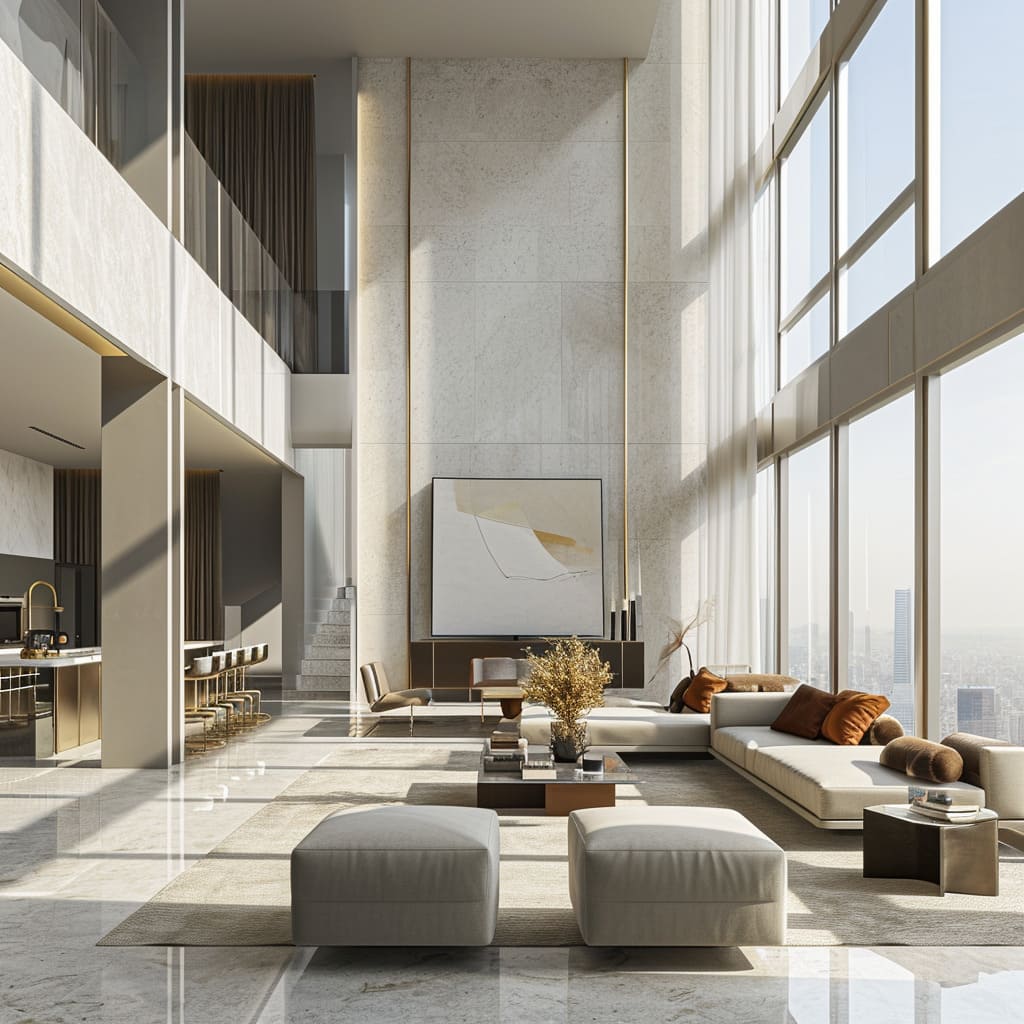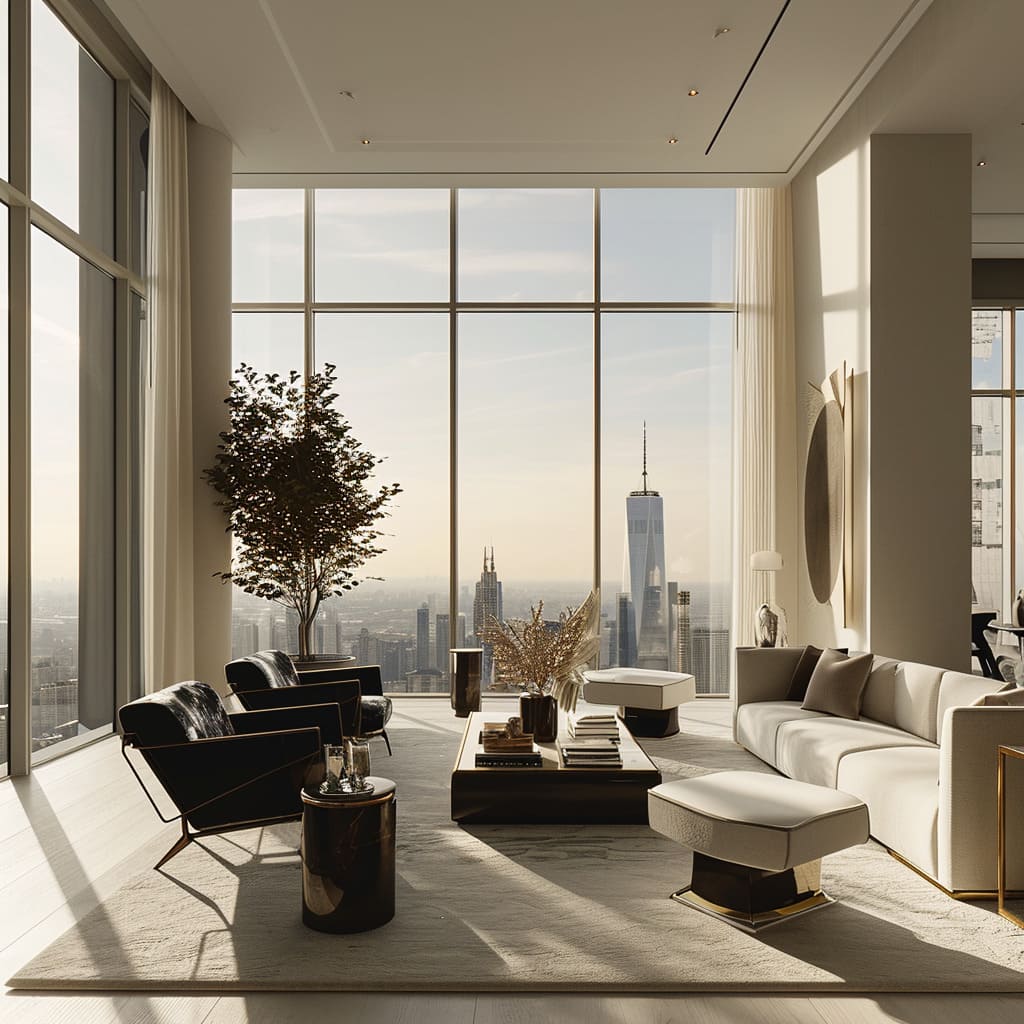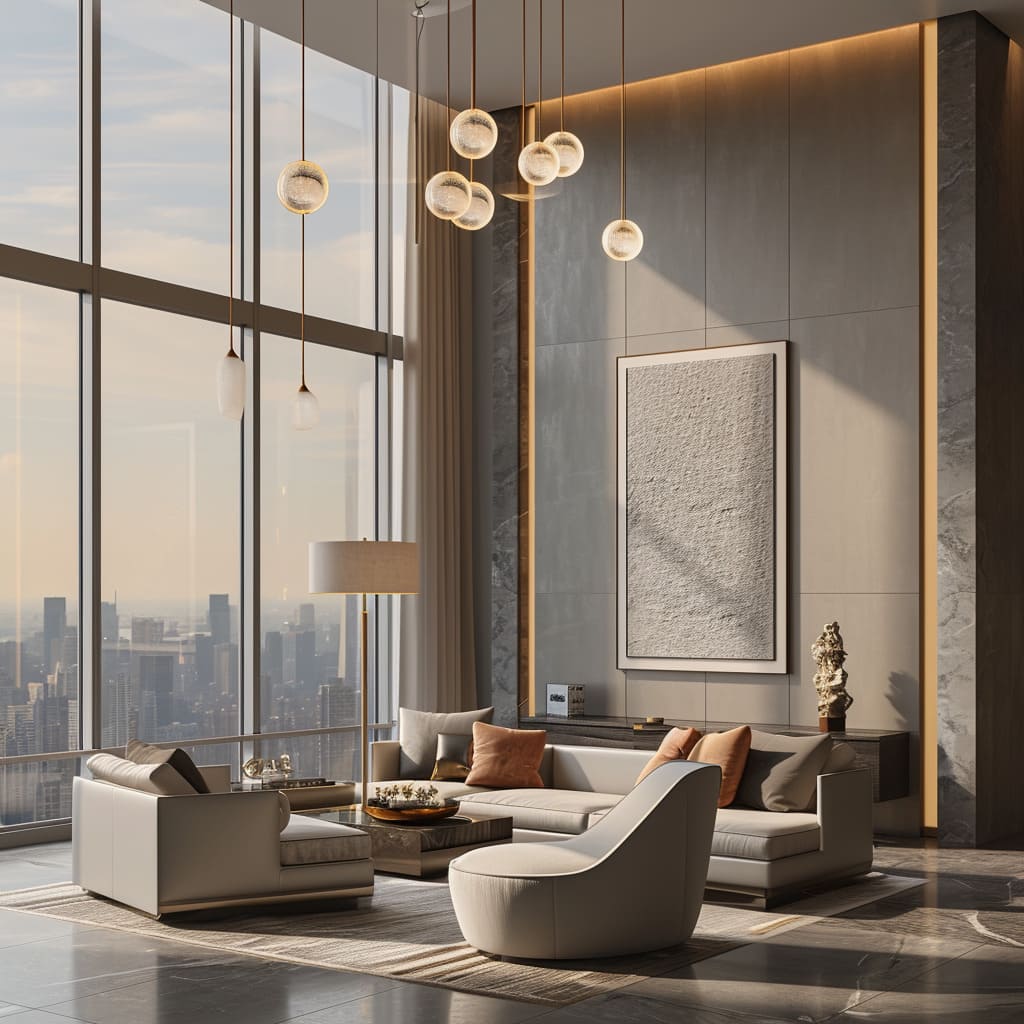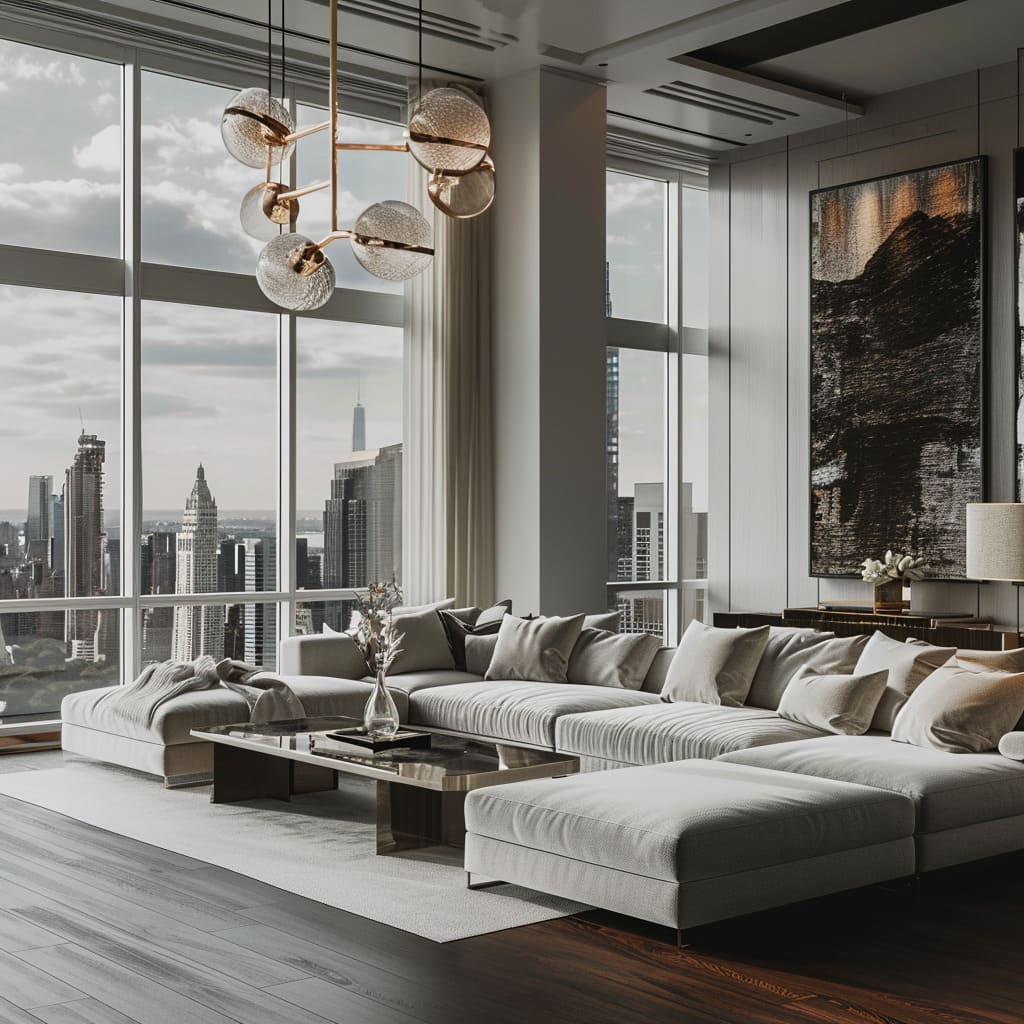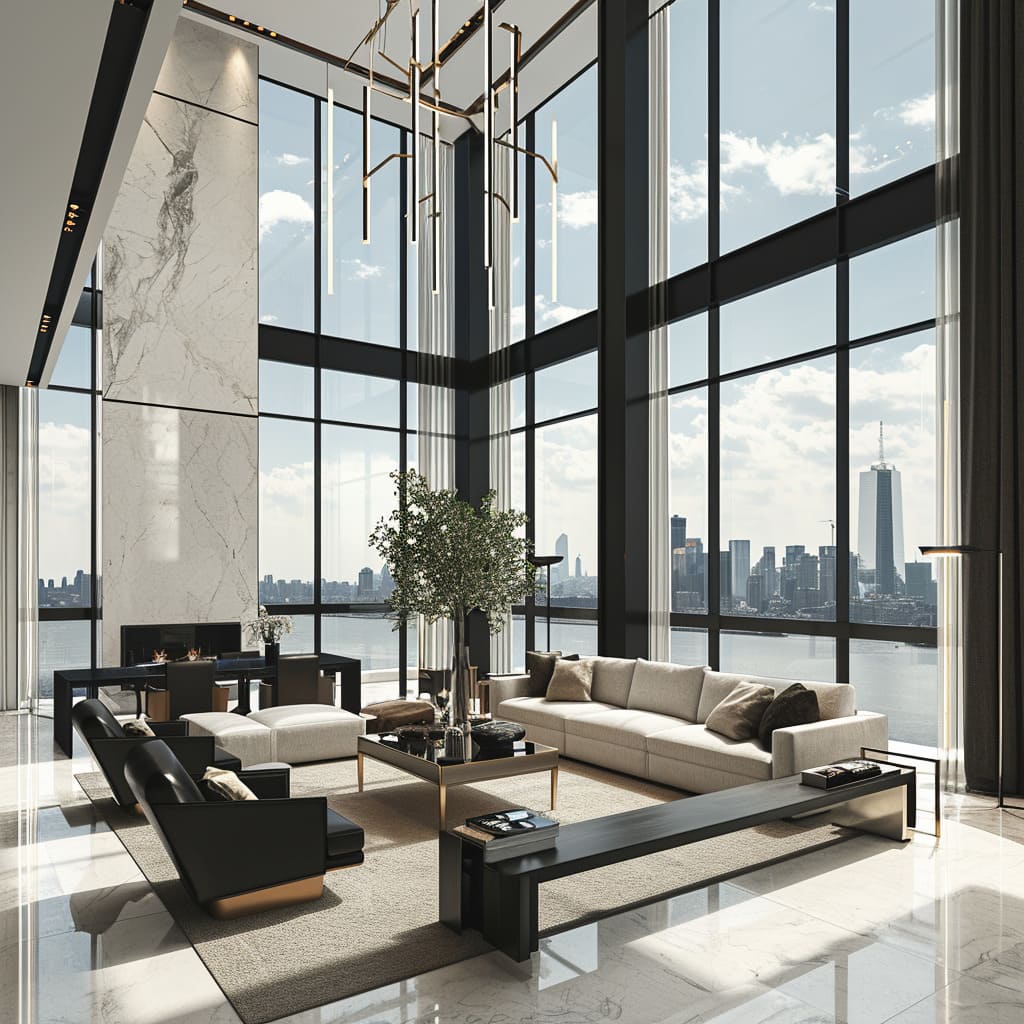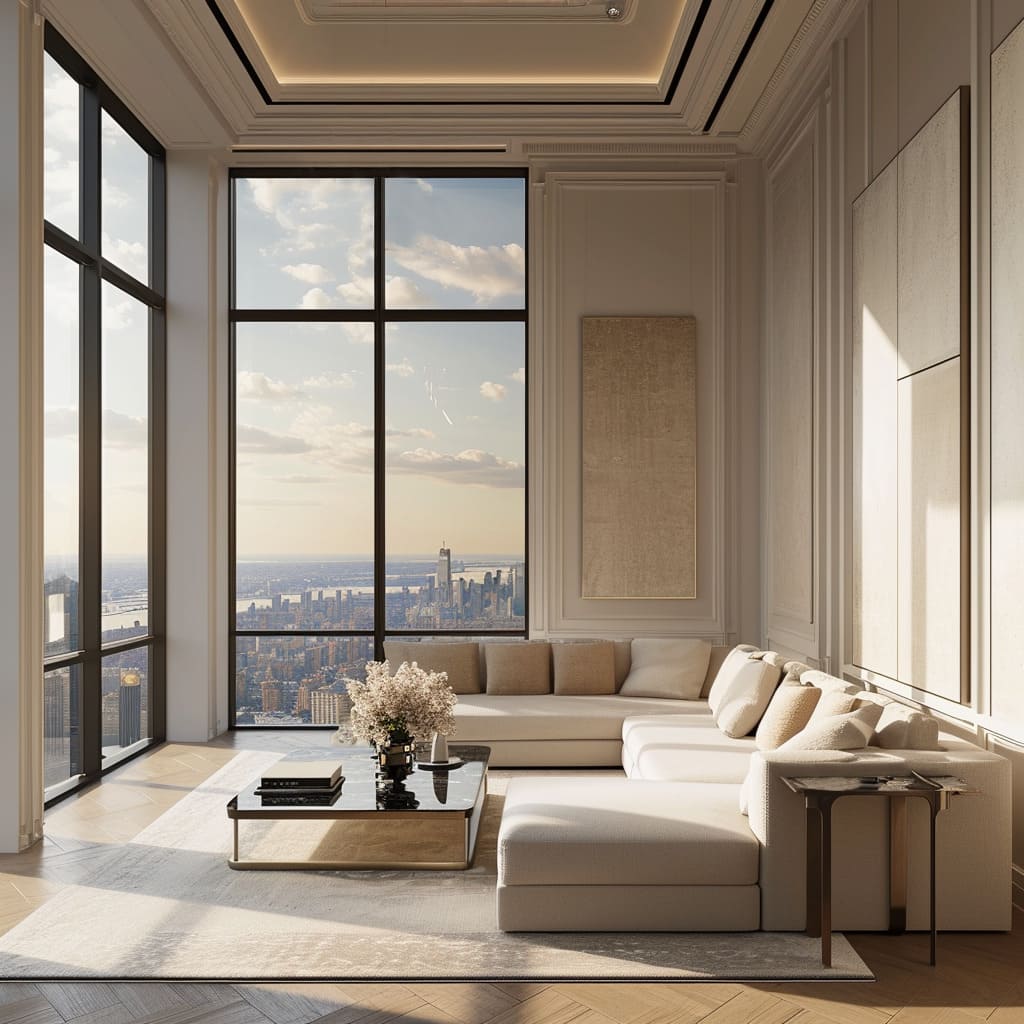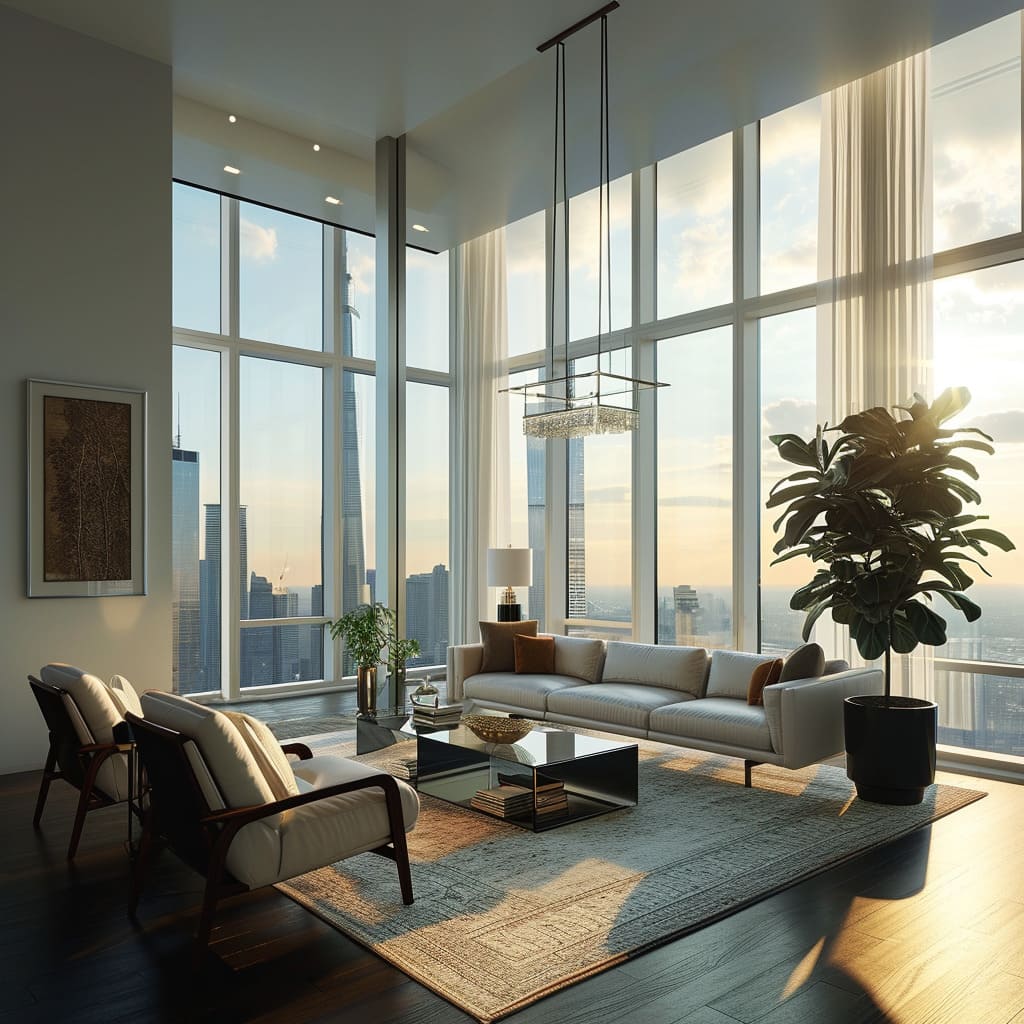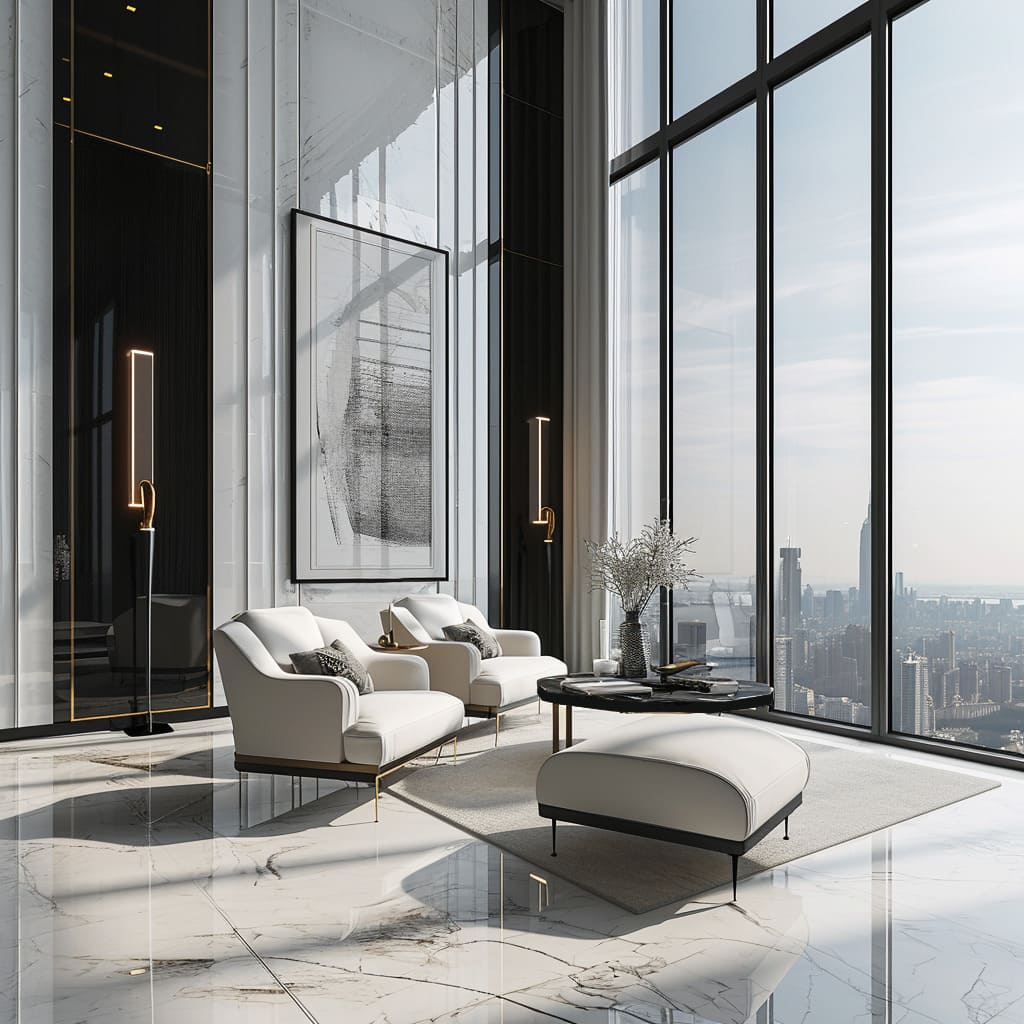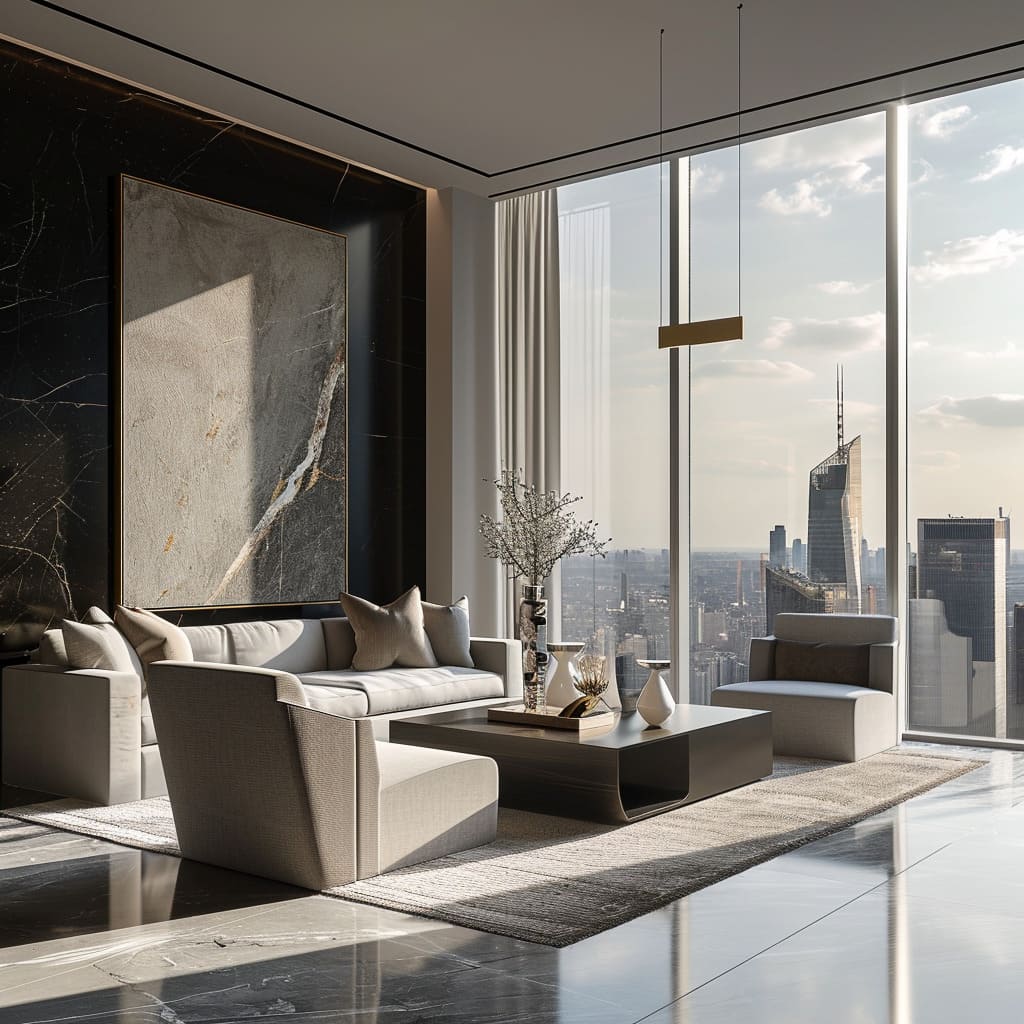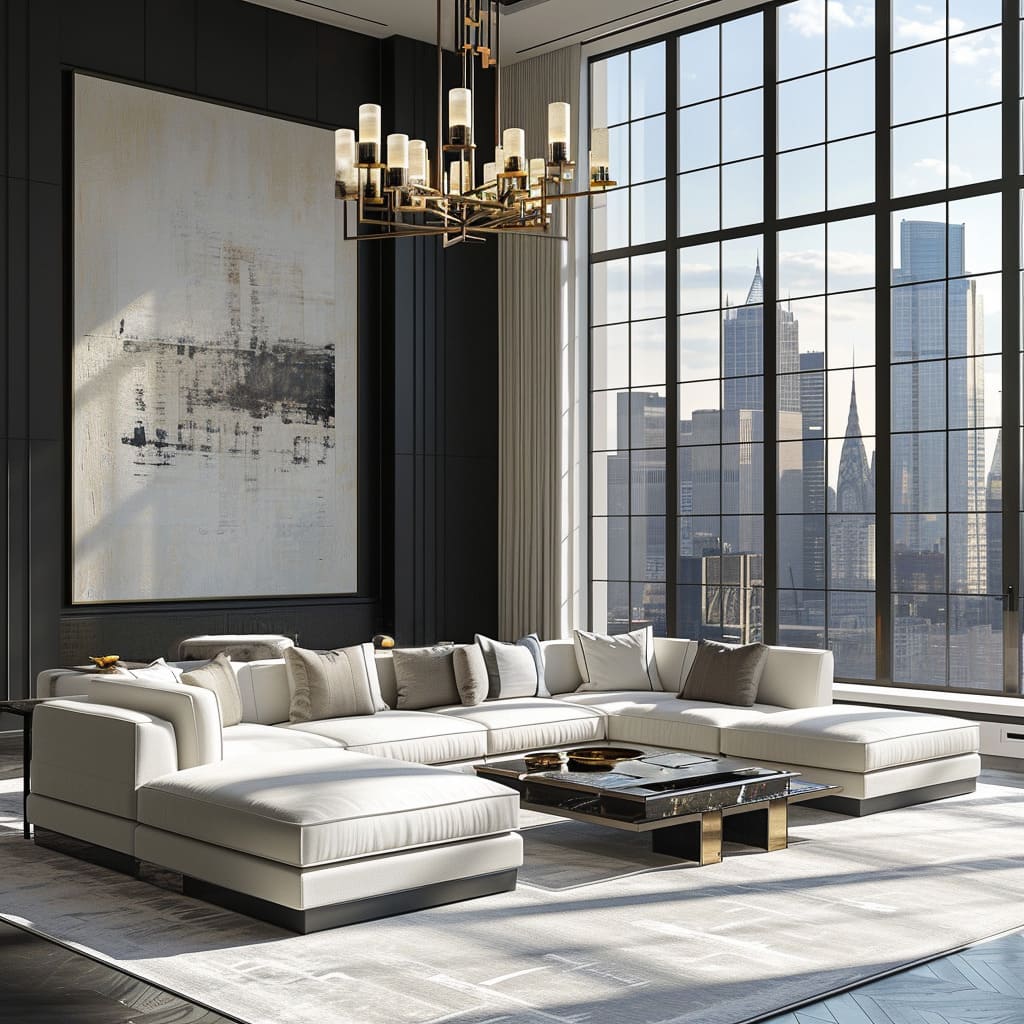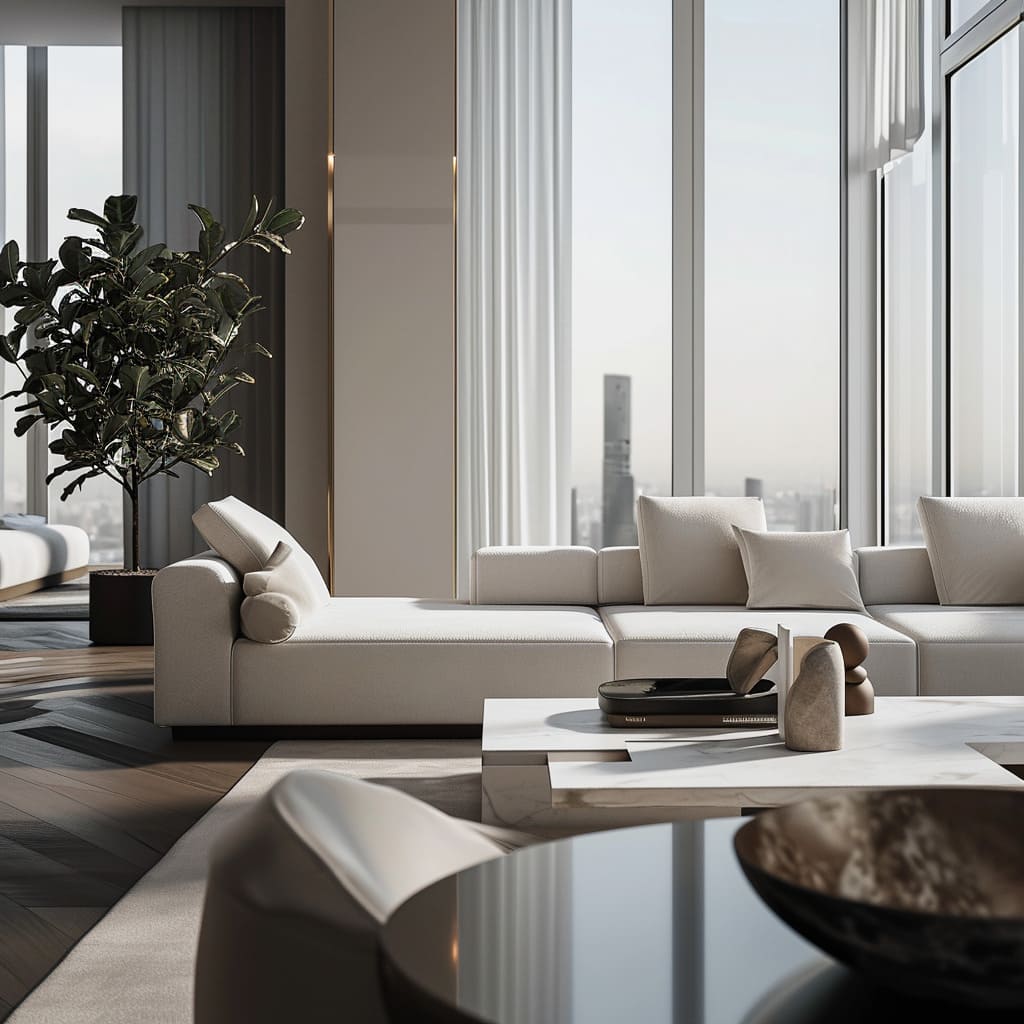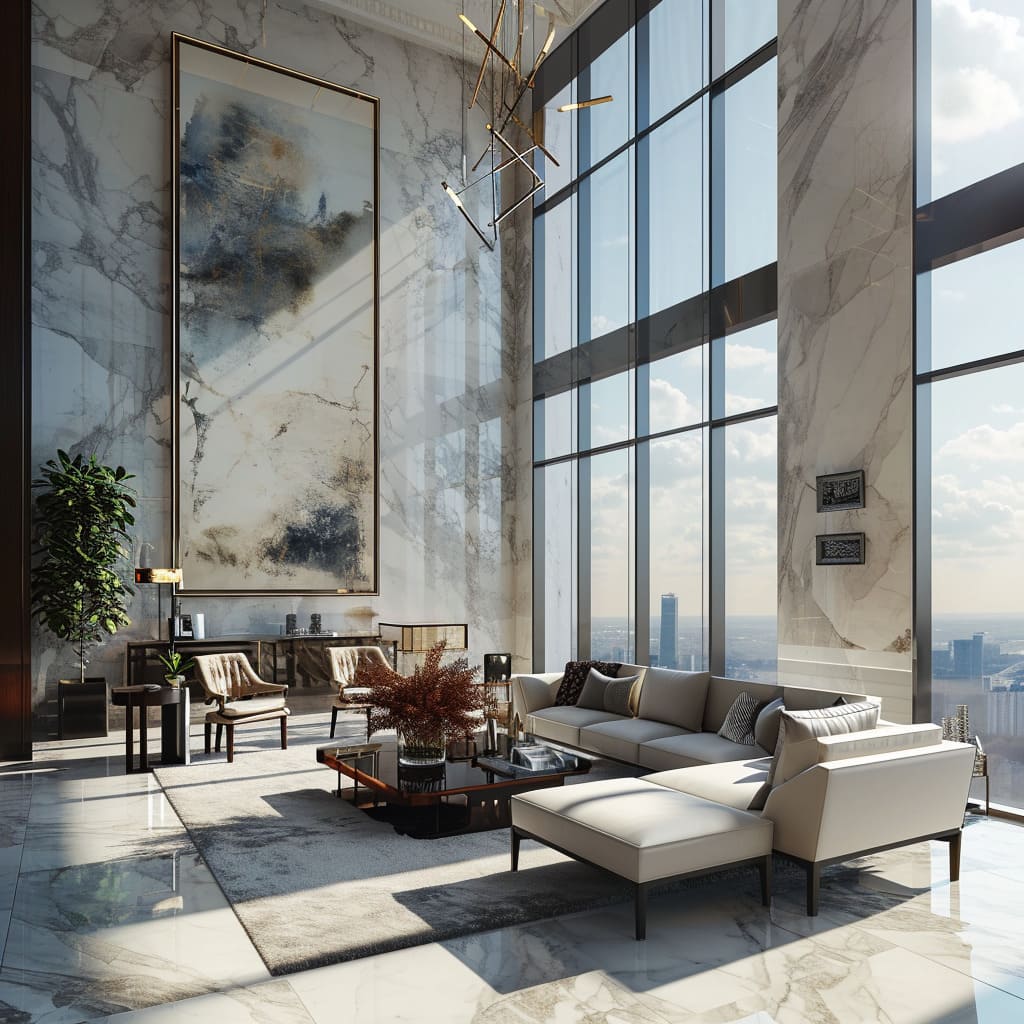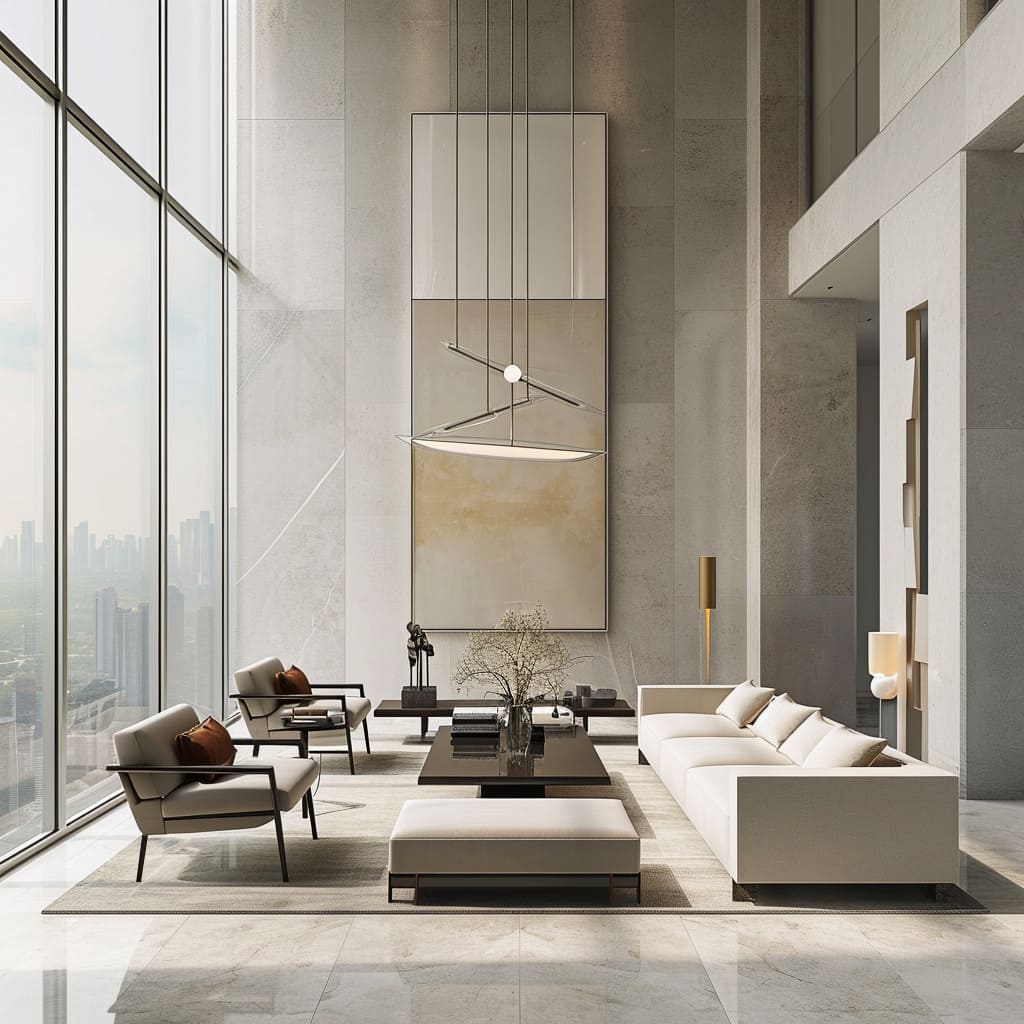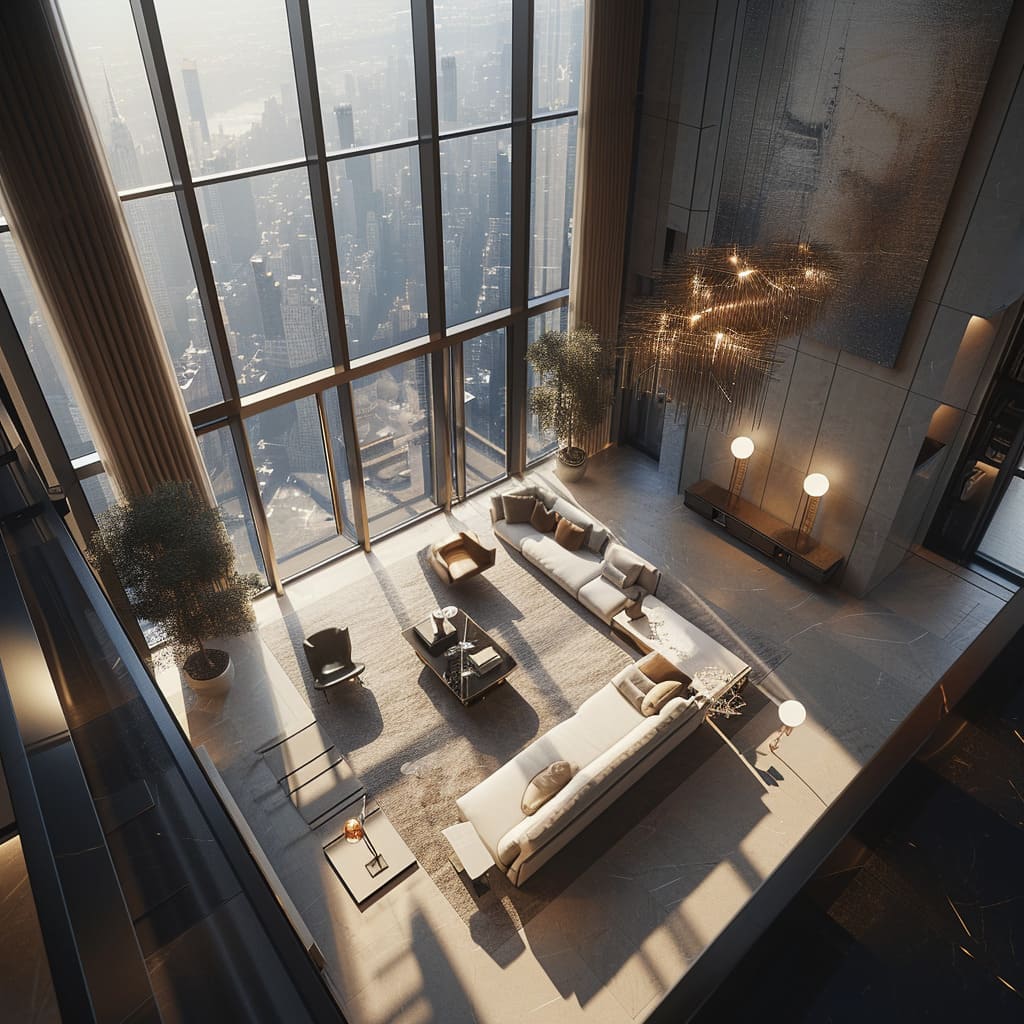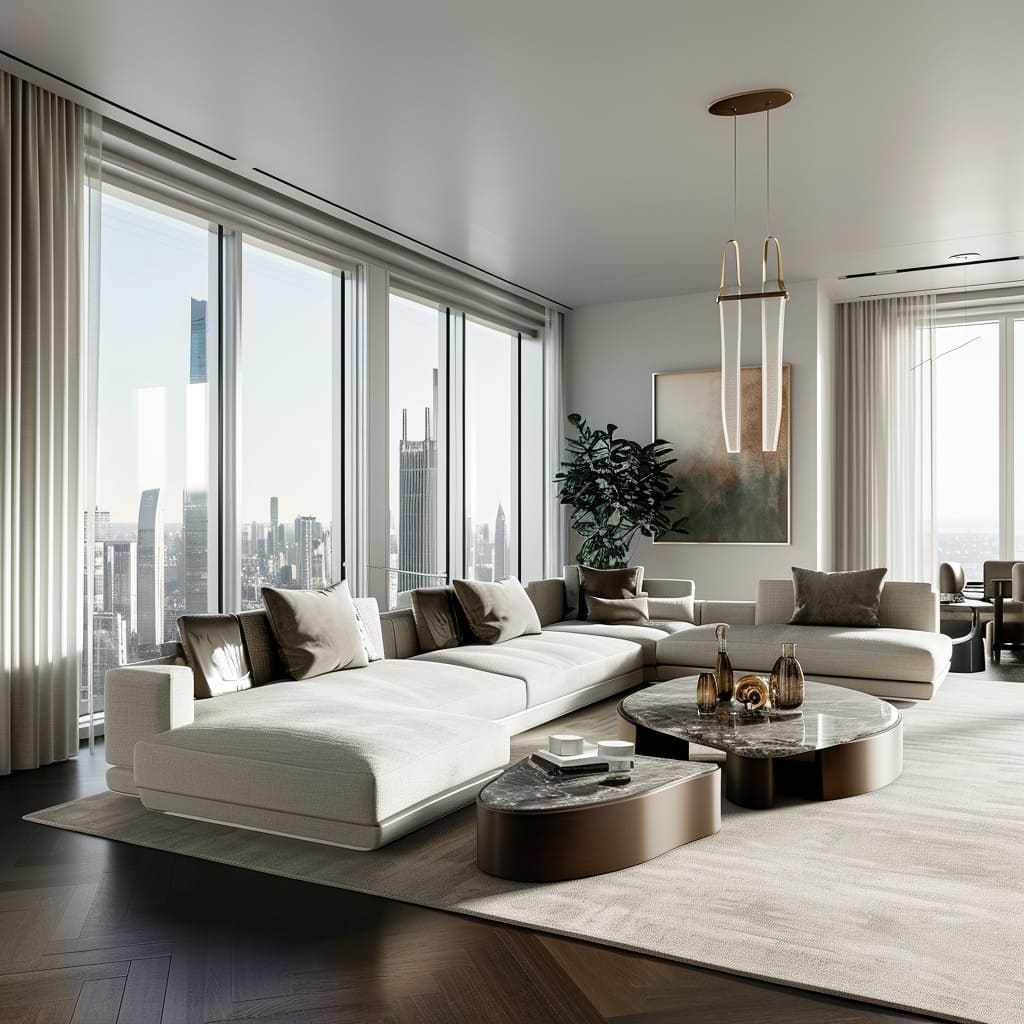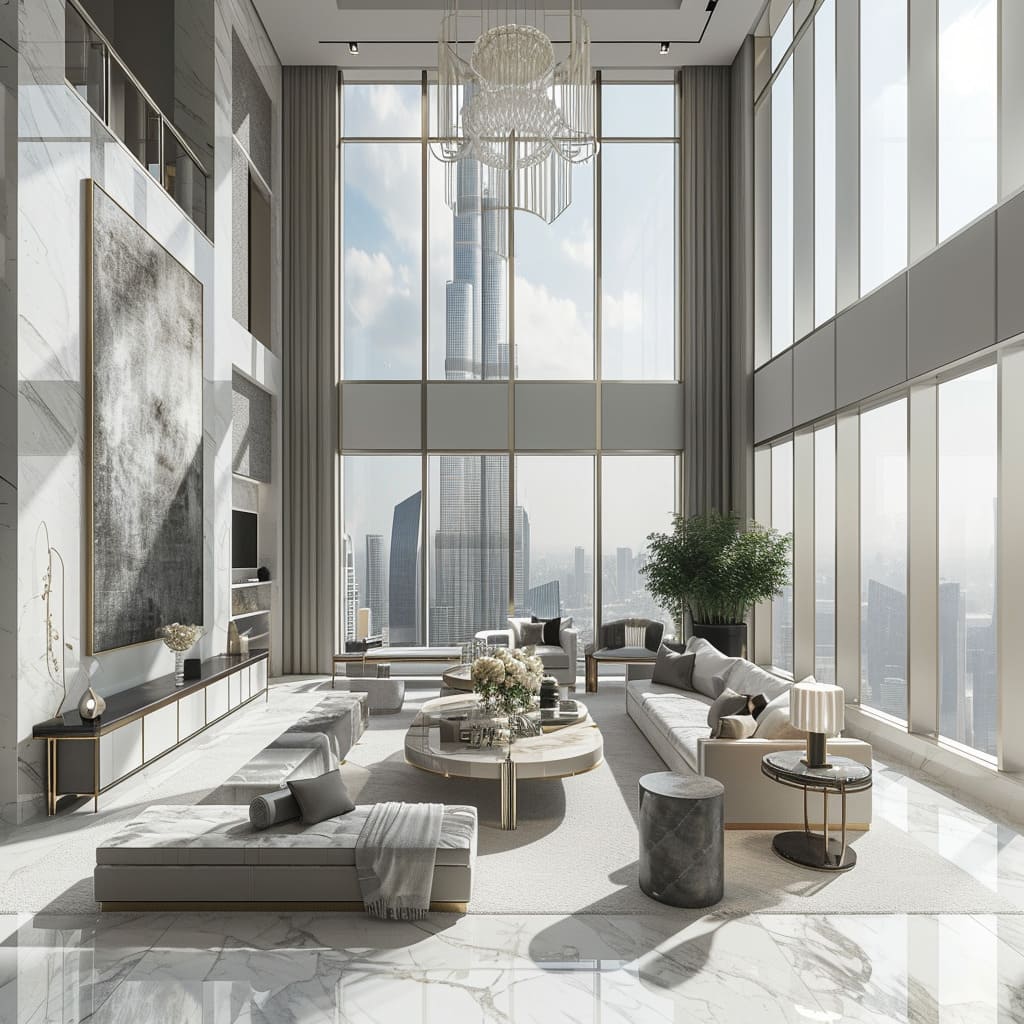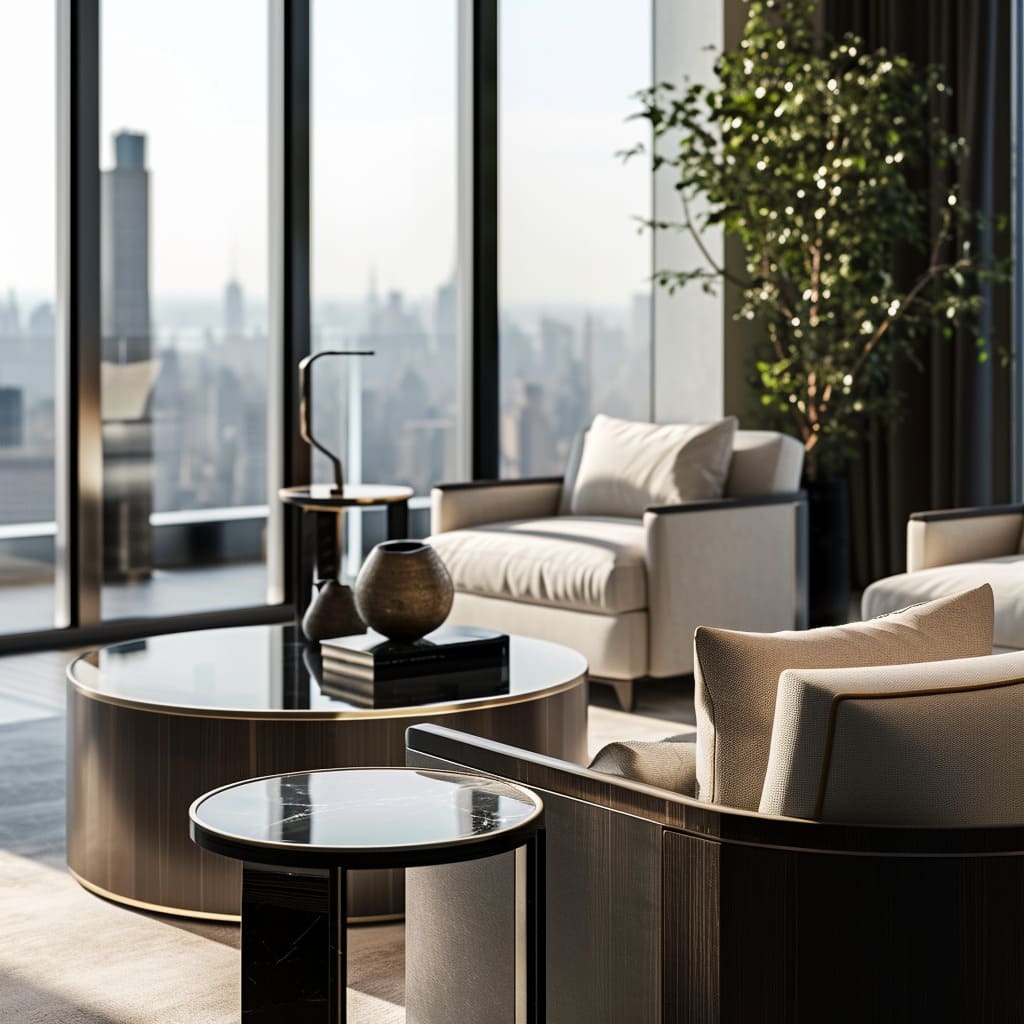In interior design, luxury is not merely an aesthetic; it’s an experience that is felt as much as it is seen. The alchemy of creating a space that resonates with elegance, sophistication, and tranquility is an art form that blends architectural prowess with design sensitivity.
The interiors we are about to explore are paragons of this philosophy, where every element is meticulously crafted to not only reflect the tastes of the inhabitants but also to enhance their daily living experience. From the interplay of natural light to the fine materials and textures that speak of quality and care, these spaces are the epitome of modern luxury living.
As we dissect the main features of these luxurious interiors, we will uncover the design principles that transform high-end spaces into personal havens and architectural masterpieces.
Expansive Windows and Natural Light
Each room features floor-to-ceiling windows that allow for an abundance of natural light, which illuminates the space and creates a seamless integration with the outside environment. This openness adds a sense of grandeur and is a key feature of luxury interior design, emphasizing panoramic views and a connection to the cityscape.
Beyond the initial visual impact, the expansive windows serve a deeper psychological purpose. They invite the outside world in, creating an environment where the barriers between interior and exterior blur.
The changing light throughout the day dynamically alters the mood and ambiance of the space, which provides a living backdrop that continuously refreshes the interior.
The natural light also plays a practical role in wellness, offering a connection to the natural rhythm of day and night, which can improve the occupants’ circadian rhythms and overall well-being.
Explore our feature on how modern architecture enhances living spaces with large windows that connect kitchens to the outdoors.
Neutral Color Palette
The dominant use of neutral colors such as beige, cream, and gray, serves as a sophisticated backdrop that highlights the architecture and furniture. This color scheme conveys a timeless elegance and creates a calming atmosphere.
The neutral color palette is more than just a safe choice; it offers a versatile canvas for homeowners to personalize the space with art or accent pieces that can be changed over time without a complete redesign. It creates a serene and cohesive look that can make the space feel larger and more open.
High-Quality Materials
The interiors include high-quality materials like marble, glass, polished metal, and rich textiles, which contribute to the sense of luxury. These materials are used for flooring, wall accents, and furniture finishes, and they reflect light to further enhance the sense of space.
The use of high-quality materials is not only about aesthetics but also durability and sustainability. Materials like marble and hardwood are long-lasting and can withstand the test of time, both in style and function.
They provide a tactile experience that is synonymous with luxury; the cool smoothness of marble, the warmth of wood, and the crispness of metal. These materials also often require skilled artisans to install, reflecting a commitment to craftsmanship and attention to detail.
Statement Lighting
Each space features distinctive light fixtures that act as focal points. Whether it’s the modern chandelier with multiple bulbs, the unique floor lamps, or the elegant pendant lights, these lighting elements are both functional and sculptural, adding to the visual interest of the rooms.
The statement lighting fixtures are as much about art as illumination. Their designs often reflect current trends in art and design, and they can set the tone for the entire space.
During the day, these pieces act as sculptural elements that attract the eye, while in the evening, they come alive with light, casting patterns and creating an intimate atmosphere. The choice of lighting can transform a space from bright and energizing to soft and romantic, highlighting the adaptability of the space to different moods and occasions.
Clean Lines and Minimalism
The furniture and layouts exhibit clean lines and a minimalist approach, avoiding clutter. Each piece is carefully selected and placed to balance aesthetics with comfort, and the lack of excess decor helps to maintain a tranquil environment.
The emphasis on clean lines and minimalism reflects a philosophical stance on living with only what is necessary. It creates an uncluttered space that encourages clarity of thought and a sense of order.
In a world that is often chaotic and overstimulated, such spaces can serve as sanctuaries. Moreover, minimalist design requires a precise and thoughtful selection of pieces, meaning that each item within the space needs to be purposeful and of high quality.
Art and Accessories
The use of artwork and accessories is restrained but impactful. Sculptures, vases, and select pieces of wall art contribute to the personality of the space without overwhelming it.
These items are often used to add a touch of color or texture to the neutral base.
While minimalist, the carefully curated art and accessories are conversation starters and personal touches that reflect the owner’s taste and interests. They serve as windows into the personality of the inhabitants, providing depth and context to the neutral backdrop.
These elements are often the pieces that resonate with visitors, offering a story and history that can be shared and appreciated, making the space not just a house, but a home.
Layered Textures
Despite the minimalist color palette, there is a rich layering of textures. From the plush rugs to the soft throw pillows and the sleek leather of seating, the combination of different materials adds depth and warmth to the rooms.
The layered textures in a room are an invitation to touch and experience the space, not just visually but with all the senses. They can evoke emotions and memories, such as the comfort of a soft wool throw or the luxury of a silk cushion.
Textures can also be used to delineate areas within a larger space, creating cozy corners or highlighting a particular seating area as the centerpiece of the room.
Functional Zones
Each space is carefully zoned to maximize functionality. Seating arrangements are designed for socializing, while quieter corners are set up for relaxation or reading, showing a thoughtful consideration of how the space will be used.
The creation of functional zones within an open plan is a thoughtful exercise in understanding the daily habits and needs of the occupants. It’s about creating an ecosystem within the home where each activity has its place, whether it’s a quiet nook for contemplation or a communal area for gathering.
This deliberate zoning helps manage sound and activity flow, ensuring that the home supports both social engagement and personal retreat.
Integration of Technology
While not overtly visible, there’s an implication of integrated technology for comfort and convenience, such as automated window shades or advanced lighting systems, which are often features of modern luxury interiors.
Modern luxury is often characterized by the seamless integration of technology that enhances living without intruding upon it. Hidden speakers, invisible climate control, and subtle home automation all contribute to an environment where the focus is on comfort and ease.
This integration is carefully planned to ensure that technology serves the design, rather than dictates it, maintaining the aesthetic integrity of the space.
Spatial Flow
The arrangement of the furniture and the open floor plan facilitate a smooth flow within the space. This is essential in luxury design, as it allows occupants to move freely and comfortably, further emphasizing the expansiveness of the interior.
The strategic placement of furniture and the design of the space itself facilitate not just physical movement, but also the visual and energetic flow. The way in which the eye is drawn through the space, how areas are revealed as one moves through the home, and the balance between filled and empty spaces all contribute to a sense of harmony.
This flow can influence the way occupants interact with their environment, promoting a tranquil yet dynamic living experience.
In conclusion, the luxury interior designs exemplified represent a harmonious blend of form and function, underpinned by a meticulous selection of materials, colors, and textures. These spaces are not just aesthetically pleasing; they are thoughtfully crafted environments that elevate the standard of living.
The expansive use of glass invites the outside in, creating a canvas that changes with the time of day and season, while the neutral color palette provides a timeless elegance that can adapt to evolving tastes.
The high-quality materials selected speak to a legacy of durability and artisanship, while the statement lighting and minimalistic approach to decor ensure that each piece holds significance and contributes to the overall narrative of the space. The curated art and accessories add a personal touch, transforming these interiors into unique expressions of the individuals who reside within them.
Layered textures and functional zoning cater to the sensory and practical needs of daily life, creating spaces that are as comfortable as they are beautiful. The integration of technology further enhances the living experience, offering convenience without compromising the design’s integrity.
And finally, the thoughtful consideration of spatial flow ensures that these environments support a lifestyle that is both vibrant and restful.
These interiors, with their emphasis on light, space, and quality, epitomize a modern sanctuary, offering a retreat from the bustling world outside. They are a testament to the power of interior design to not only create beautiful spaces but to improve the quality of life for those who inhabit them.


